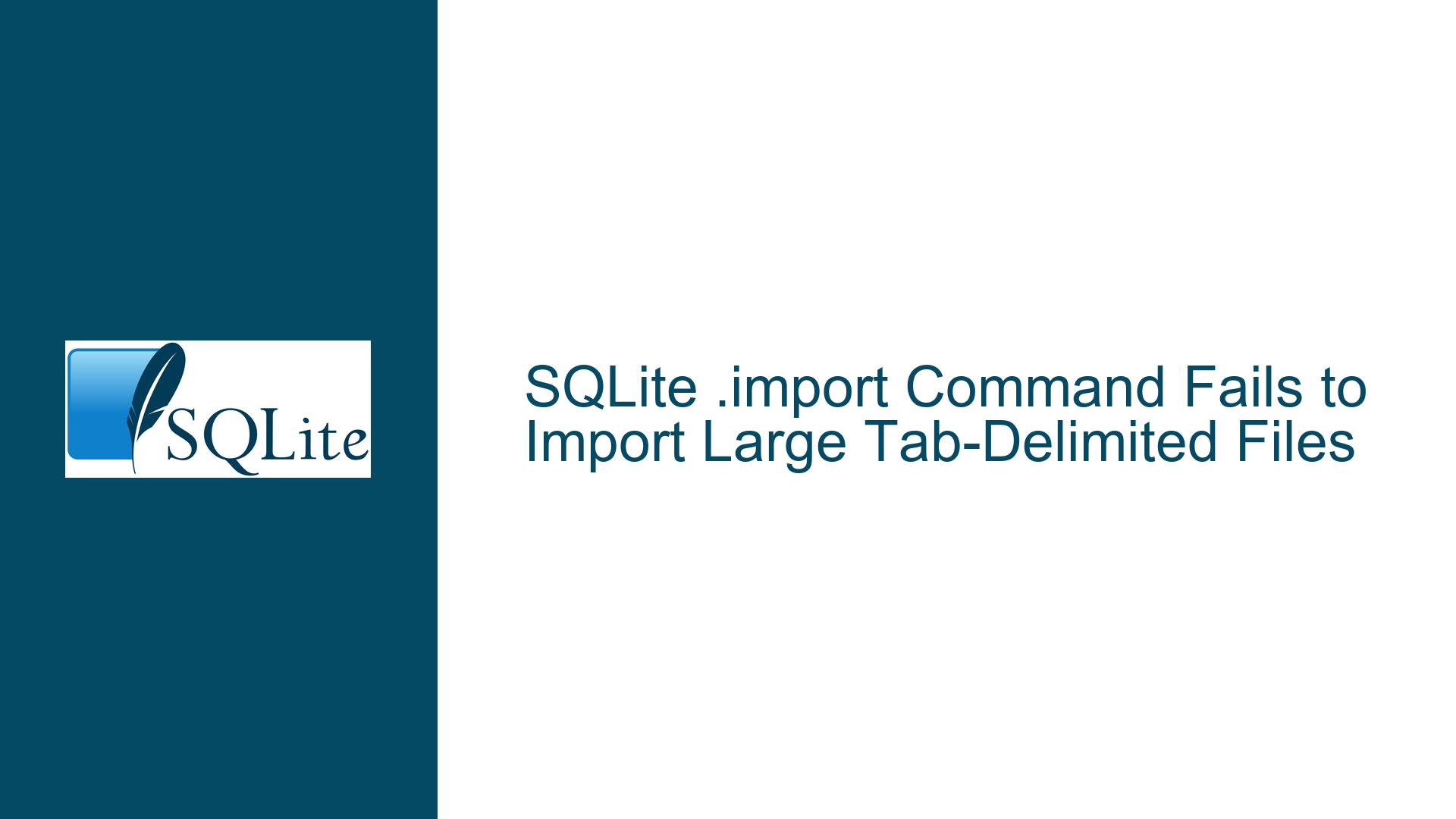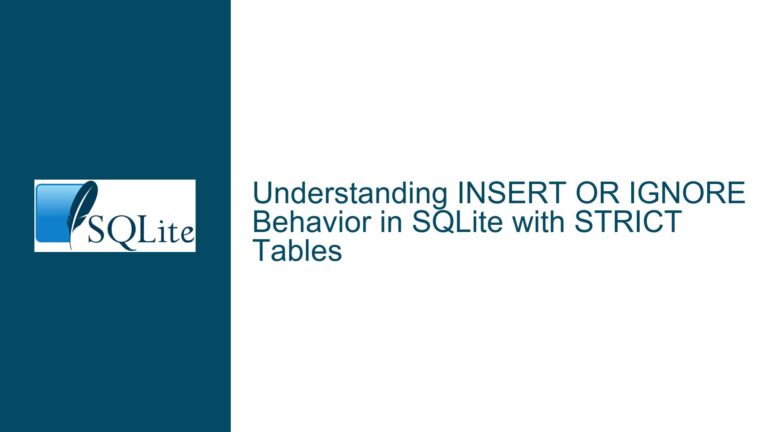SQLite .import Command Fails to Import Large Tab-Delimited Files
Incomplete Data Import with SQLite’s .import Command
When attempting to import a large tab-delimited file into an SQLite database using the .import command, users may encounter a situation where only a subset of the rows is imported. This issue is particularly perplexing because the command executes without any explicit errors, yet the resulting table contains significantly fewer rows than the original file. For instance, a file with 518,548 rows might only import 145,741 rows, leaving the rest unprocessed. This problem is not consistent across all scenarios, as reducing the number of columns or the size of the file often allows for a complete import. This suggests that the issue is tied to the file’s size or complexity rather than the data itself.
The .import command in SQLite is designed to read data from a file and insert it into a specified table. It is a convenient tool for bulk data loading, especially when dealing with structured text files like CSV or TSV. However, its behavior can be unpredictable when handling large files or files with a high number of columns. The lack of error messages during the import process further complicates troubleshooting, as it provides no immediate clues about what might be going wrong.
One of the key observations in such cases is that the problem often manifests at a specific row count, regardless of the data’s content. This indicates that the issue might be related to internal limitations or resource constraints within SQLite, rather than the data’s format or structure. Additionally, the problem appears to be more prevalent in older versions of SQLite, such as version 3.7.14.1, which may lack optimizations or bug fixes present in more recent releases.
File Size and SQLite Version Constraints Leading to Partial Imports
The root cause of the incomplete import issue can often be traced back to two primary factors: the size of the input file and the version of SQLite being used. Large files, particularly those exceeding a certain size threshold, can strain SQLite’s import mechanism, especially in older versions. SQLite’s .import command processes files line by line, and when dealing with large files, it may encounter memory or resource limitations that prevent it from completing the operation successfully.
Another contributing factor is the version of SQLite in use. Older versions, such as 3.7.14.1, may have inherent limitations or bugs that affect the .import command’s ability to handle large files. Over the years, SQLite has undergone numerous improvements, including enhancements to the .import command’s efficiency and reliability. These improvements may not be present in older versions, leading to inconsistent behavior when importing large datasets.
The issue is further compounded by the fact that reducing the file’s size or the number of columns often resolves the problem. This suggests that the .import command’s performance is sensitive to the amount of data being processed at once. When the file is too large or contains too many columns, SQLite may struggle to manage the data efficiently, resulting in incomplete imports. This behavior is particularly evident in scenarios where the file size exceeds a certain threshold, such as 27,006 KB, as reported in some cases.
Additionally, the order of the rows in the file does not appear to influence the outcome, as rearranging the rows does not resolve the issue. This indicates that the problem is not related to specific data anomalies or formatting issues within the file. Instead, it points to a systemic limitation within SQLite’s import mechanism, particularly in older versions.
Upgrading SQLite and Optimizing File Size for Successful Imports
To address the incomplete import issue, users should consider two primary solutions: upgrading to a more recent version of SQLite and optimizing the size of the input file. Upgrading SQLite to a newer version, such as 3.31.1 or later, can significantly improve the .import command’s performance and reliability. Newer versions of SQLite include numerous optimizations and bug fixes that enhance its ability to handle large files and complex datasets. If upgrading is not an option due to compatibility constraints, users should explore alternative methods for importing data, such as splitting the file into smaller chunks or using a different tool for the initial data load.
Optimizing the file size is another effective strategy for ensuring a successful import. Users can achieve this by reducing the number of columns or splitting the file into smaller segments. For example, if the original file contains seven columns, users can create a simplified version with only two columns to test whether the issue persists. If the simplified file imports successfully, it confirms that the problem is related to the file’s size or complexity. In such cases, users can proceed to split the original file into smaller chunks and import them sequentially.
Another approach is to use a script or program to preprocess the file before importing it into SQLite. For instance, a Perl script can be used to generate a tab-delimited file with a specific number of rows and columns, allowing users to test the .import command’s behavior under controlled conditions. This method can help identify the exact point at which the import process fails, providing valuable insights into the underlying cause of the issue.
In cases where upgrading SQLite or optimizing the file size is not feasible, users can explore alternative data import methods. For example, they can use SQLite’s INSERT statement to manually insert data into the table, or they can use a third-party tool to convert the file into a format that SQLite can handle more efficiently. While these methods may require additional effort, they can provide a reliable workaround for the incomplete import issue.
In conclusion, the incomplete import issue with SQLite’s .import command is a complex problem that can be attributed to file size and SQLite version constraints. By upgrading to a newer version of SQLite and optimizing the size of the input file, users can significantly improve the likelihood of a successful import. Additionally, alternative data import methods can provide a reliable workaround for cases where upgrading or optimizing the file is not an option. By following these troubleshooting steps, users can overcome the challenges associated with importing large tab-delimited files into SQLite and ensure the integrity of their data.






